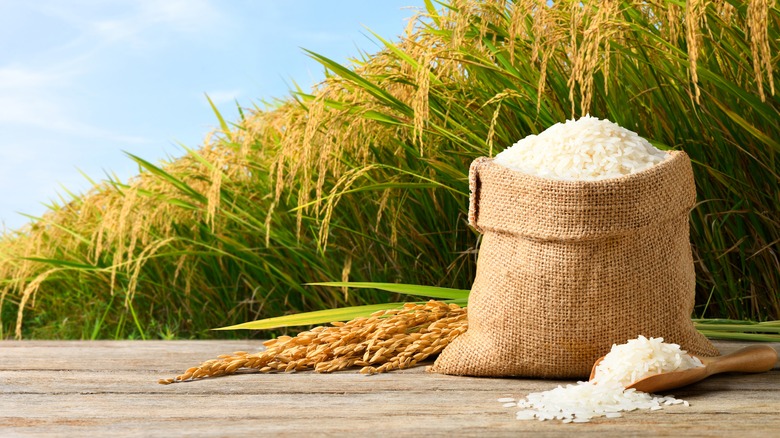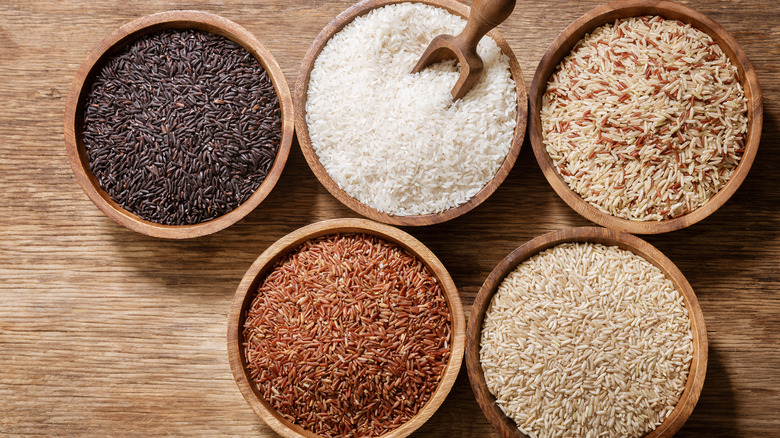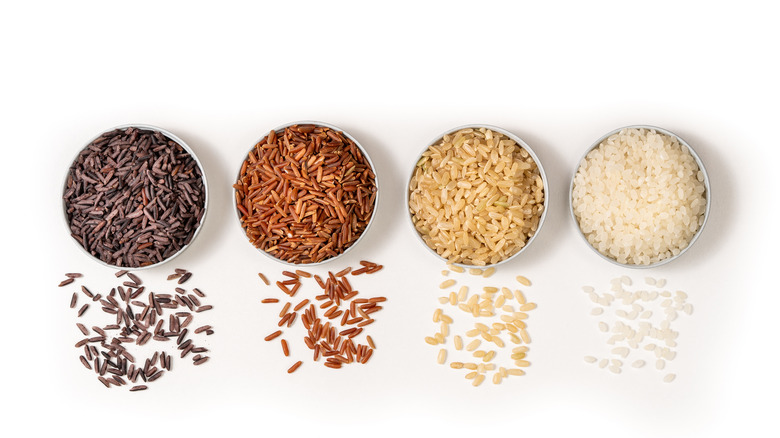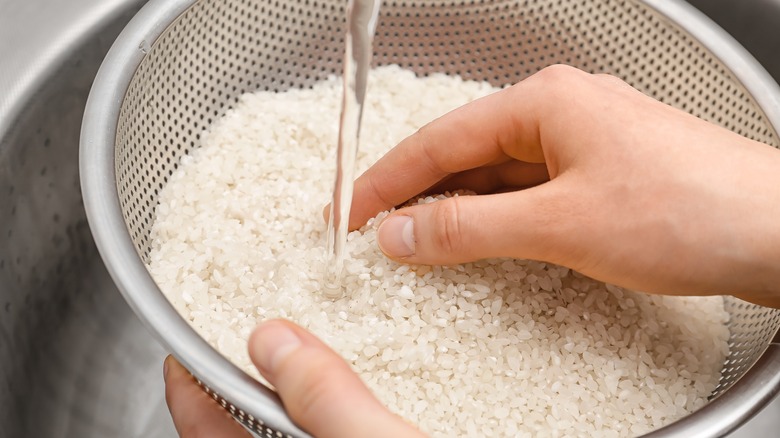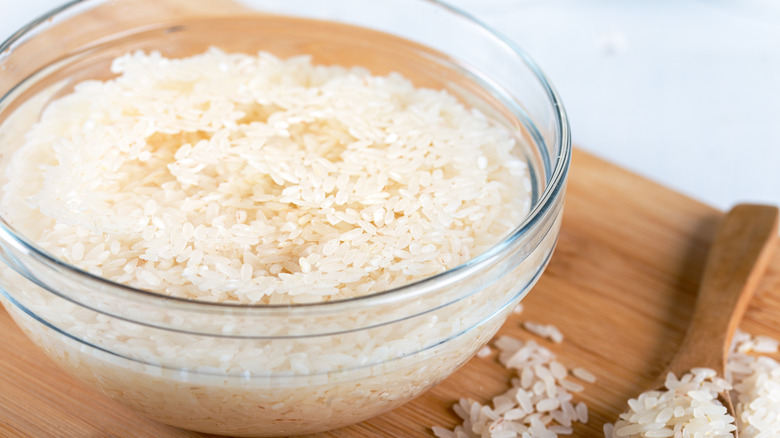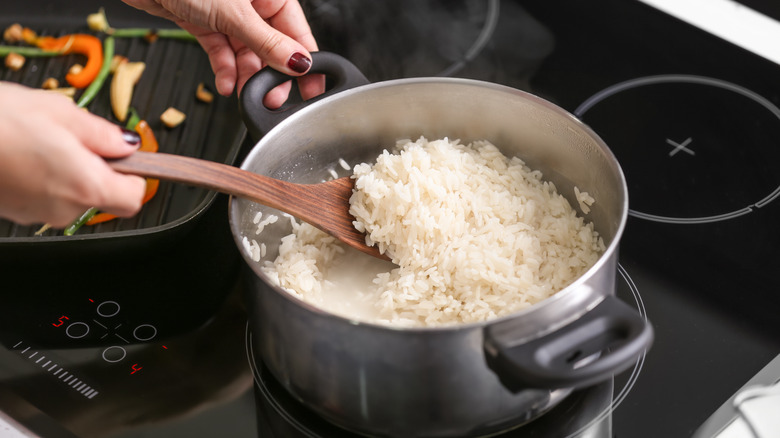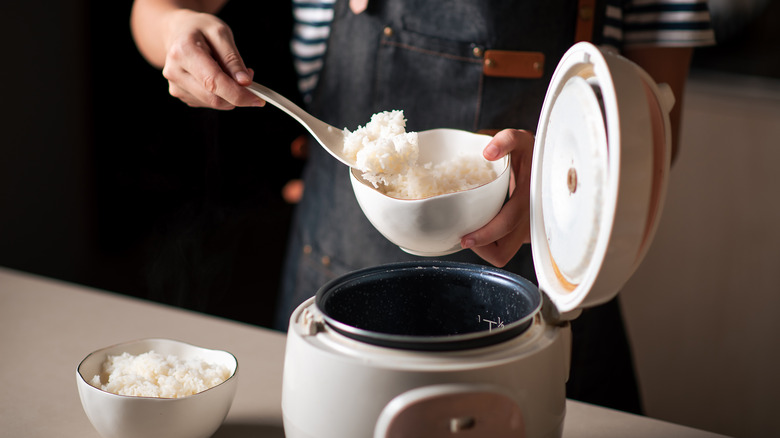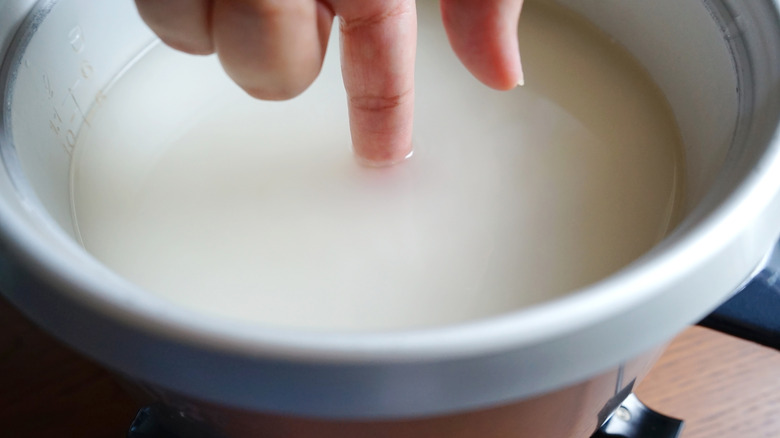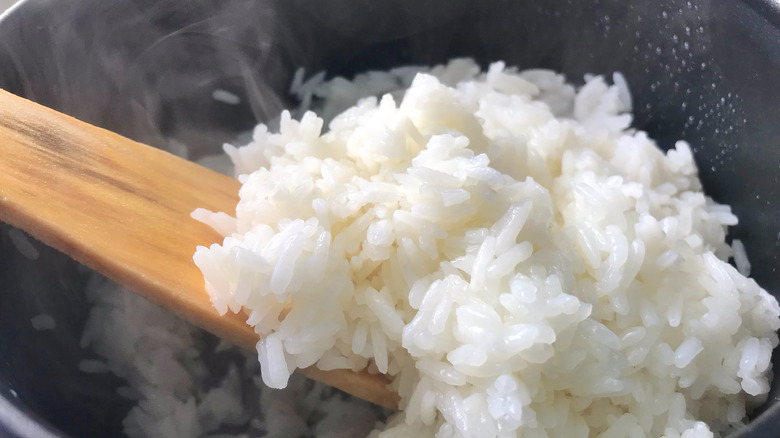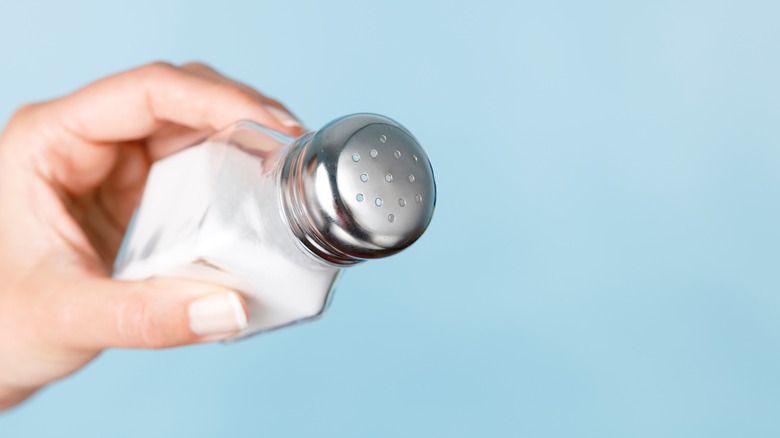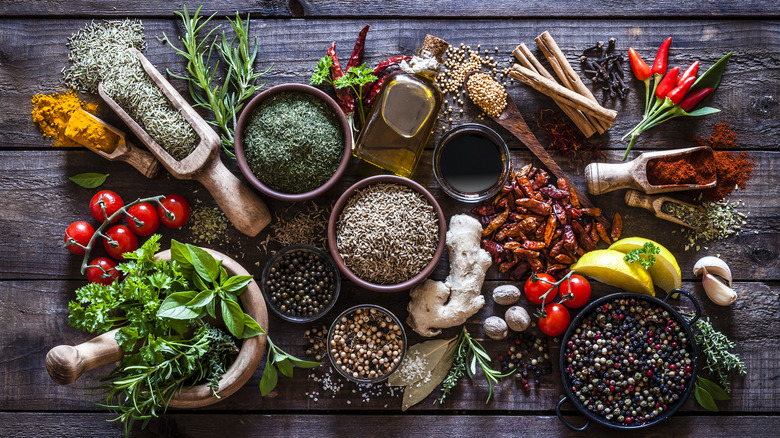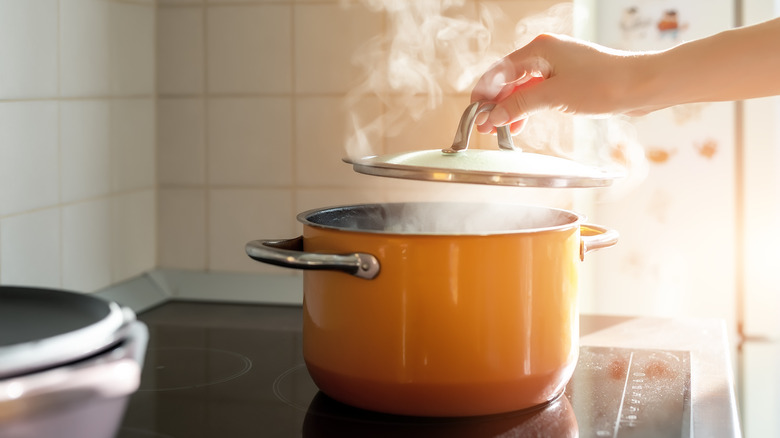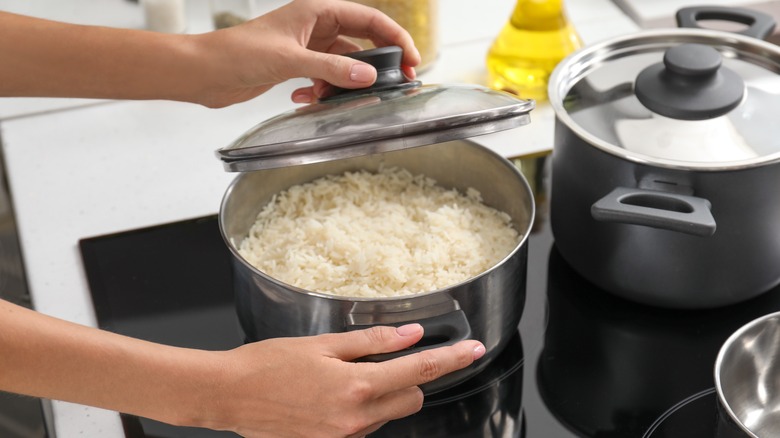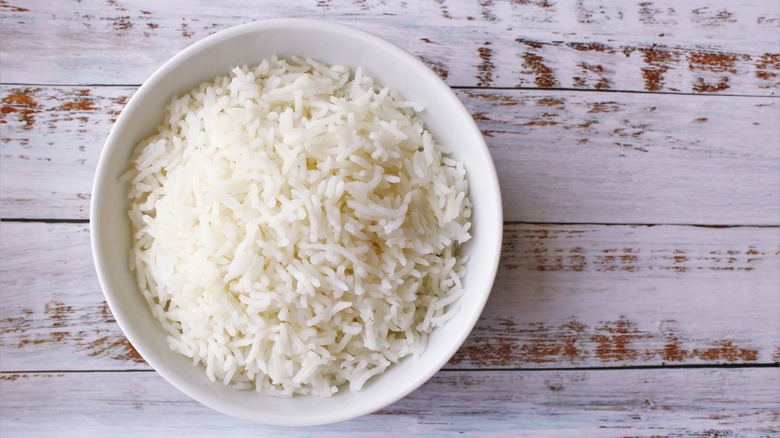Mistakes Everyone Makes When Cooking Rice
Already cultivated thousands of years ago, today, rice serves as a culinary staple for 3.5 billion people around the globe (via National Geographic). This vital food source is also ultra versatile, appearing in a wide range of dishes from creamy risottos and flavorful biryanis to sushi rolls. It's precisely this adaptability that has made rice an integral part of different cultures and diets worldwide.
Despite its popularity, cooking rice can be an intimidating experience, especially for those without much culinary know-how. From choosing the right rice type and cooking method to rinsing, soaking, seasoning, and fluffing, cooking rice can be a minefield. The good news is that with a few simple tips, anyone can master the art of cooking rice to perfection. Whether you're an absolute novice or looking to enhance your rice-cooking skills, achieving the perfect results is well within your reach.
With this in mind, here are some of the most common mistakes to steer clear of when preparing rice.
Ignoring different rice varieties
While we are all familiar with white rice and may have sampled basmati or jasmine rice, these varieties are just the tip of a colossal iceberg. According to the Rice Association, there are over 40,000 types of cultivated rice, most of which demonstrate different characteristics when cooked. This, in turn, leads to different textures and consistencies, both of which can have a huge impact on a meal.
Rice is usually classified into two categories — long-grain Indica rice and medium- or short-grain Japonica rice. While there are plenty of options within these two broad categories, two stand out as the most popular and versatile. One of the most common rice types is white rice, which has had its husk, bran, and germ removed, resulting in a fluffy and mild grain. Another prevalent grain type is brown rice, which retains its germ and bran, making it chewier than its white counterpart.
Some other commonly served rice types include basmati, a long-grain rice aged 12 months to develop a pleasant nutty flavor. Arborio, on the other hand, is typically used to make risottos. This short-grain rice contains a fair bit of starch, a quality that gives it its glutinous and creamy texture. Some other popular rice types include Chinese black rice, Thai jasmine rice, Japanese sushi rice, and wild rice, native to the Great Lakes area in the U.S.
Thinking every rice type uses the same prep and cooking rules
Even if you've been cooking rice all your life, you may end up with improperly cooked rice if you assume all rice types are created equally. Just because you know how to make one type of rice doesn't mean you know how to make every type of rice. Be sure to follow package instructions if you're trying a new rice type. Investigating the best cooking methods for each type of rice you want to make will prevent you from ending up with undercooked or overcooked rice with an unsatisfactory texture.
The differences start before cooking. Many types of rice are better if you soak them before cooking. Depending on the type of rice, the suggested soaking times range from 15 minutes to even overnight to achieve the perfect texture.
The amount of liquid you use for a single cup of rice differs depending on the type of rice you are cooking and how you cook your rice. Many varieties require about a 2:1 ratio of liquid to rice for stovetop cooking, but you'll end up using far less for short- and medium-grained rice and more for brown rice. Even the cooking times are different. While many types of rice only need 15 to 18 minutes of stovetop cooking time, parboiled rice needs at least 20 minutes, arborio needs 20 to 30 minutes, and brown rice requires 40-50 minutes.
Not rinsing the rice
When it comes to rinsing, rice isn't much different from your average apples or pears — most rice types should be washed to cleanse the kernels of any impurities. After all, none of us want to consume dust, debris, and bugs with our meals. Rinsing rice is particularly important for imported rice since it may have been processed with talc, which is a byproduct of the milling process. This generally doesn't happen with domestic rice.
Depending on the desired final result, rinsing rice generally makes it less sticky since the process removes the starch that accumulates on the surface of each kernel. As such, you might consider reducing the amount of rinsing for sushi rice or arborio rice used in risotto, as both require a certain level of stickiness. In addition, rice produced in the U.S. is sometimes enriched with vitamins and nutrients and shouldn't be pre-washed.
Rinsing rice is as straightforward as popping it in a saucepan, filling the pot with water, and gently swirling the grains around with your hand. When the water draining from the grains is more or less clear, you're good to go. To make the job easier, grab a fine mesh strainer and rinse the rice under running water.
Not pre-soaking the rice
Some rice types, such as wild rice or certain brown rice varieties, can benefit from pre-soaking. While failing to soak the kernels before cooking won't necessarily destroy the final product, if you have the time, letting the rice sit in water can elevate your meal to another level. Soaking rice has several benefits, including rinsing off phytic acid, a substance that impedes our ability to absorb iron and zinc. In addition, pre-soaking reduces cooking time, which can help some rice varieties preserve the aromatic oils normally destroyed during the cooking process.
Different grain types should be soaked for different periods depending on their shape, size, starch, and fiber content. Short-grain starchy rice such as arborio and standard polished white rice don't require pre-soaking (white rice can be soaked for 15 minutes). Jasmine, basmati, and sushi rice should be soaked for between 15 and 30 minutes. Polished brown rice should be soaked for between four and six hours. Meanwhile, unpolished white rice or unhusked, whole-grain brown, red, black, or wild rice should be soaked for between 6 and 12 hours. Last but not least, Thai-style sticky rice is best soaked overnight.
Choosing the wrong cookware
When it comes to stovetop-cooked rice, the choice of pot can have a significant impact on the final product. This is because cooking rice in an inappropriate pot can produce unevenly cooked or burnt grains. Firstly, it's imperative to select a pot that's the right size for the amount of rice you're cooking. Using a pan that's too small can cause the rice to boil over and make a mess while using a pot that's too large can result in unevenly cooked grains.
As a rule of thumb, a two-quart pot is sufficient for cooking up to two cups of dry rice. The pot's material is also important, with stainless steel and aluminum saucepans topping the list of preferred options. This is because both materials offer great heat distribution, reducing the likelihood of the rice or other food sticking to the bottom. As an added bonus, they can withstand high temperatures and are easy to clean. If possible, select a pot with a thick base to minimize the risk of any hotspots. In addition, be sure to choose a pot with a tightly-fitting lid that can keep the steam inside the pot.
Not using a rice cooker to make rice
Not just convenient and time-efficient, rice cookers deliver consistent results that can be difficult to achieve when preparing rice on a stovetop. Equipped with user-friendly interfaces and automatic cooking processes, these handy gadgets take the guesswork out of perfectly cooked rice. All you have to do is fill the appliance with the right amount of rice and water, close the lid, and press the ON button.
Once the rice is done, most rice cookers automatically switch to a "keep warm" function to ensure that the grain stays at the optimal serving temperature. This leaves you free to prep the rest of your meal without worrying about your rice getting cold. In addition, rice cookers are also very easy to clean. Simply place the inner pot and any detachable parts in the dishwasher (provided they are dishwasher-safe) and wipe the exterior of the appliance with a damp cloth.
Using the incorrect rice-to-water ratio
Whether cooking rice on the stovetop or in a rice cooker, the correct ratio of liquid to rice can mean the difference between perfectly cooked grains and a modern-day kitchen disaster. The easiest — if somewhat imprecise — way to measure the ratio of rice to water when using a rice cooker involves the "fingertip measuring method." Simply pop the rice in the cooker, rest your middle finger on top of the rice, and add water until it's level with the first joint of your digit.
Those not as inclined to throw caution to the wind might wish to opt for the more precise cup-measuring method. Since different rice types require different amounts of water, it's best to consult your rice cooker manual before proceeding. Nevertheless, as a general rule, add one-and-a-half cups of liquid for each cup of basmati rice, jasmine rice, or short- or medium-grain white rice (via Webstaurant Store).
The rice-to-water ratio is slightly different if you cook rice using the stovetop method. For medium-grain white rice, it's best to add one and a half cups of liquid for each cup of dry rice. If cooking pre-rinsed rice, decrease the liquid by two tablespoons per cup. Different rice types require different water-to-rice ratios. For a cup of sushi rice, use one cup of liquid; for a cup of jasmine rice, use one-and-a-half cups of liquid; and for basmati rice, use one-and-three-quarters cups of liquid.
Cooking the rice at the wrong temperature
While rice cookers automatically cook rice at the right temperature, preparing rice on a stovetop requires a little more pre-planning. After all, the last thing you want is rice that's uncooked on top and burned at the bottom. For uniformly cooked rice, add the kernels to boiling water, give them a stir, cover them with a lid, and turn the heat to low. Let the rice gently simmer until it reaches the desired consistency.
While, in theory, cooking rice on a stovetop may seem easy, it can be a little tricky in practice. This is because every stove is different, with electric stoves posing a set of unique challenges since they aren't as fast to respond to temperature adjustments as their gas counterparts. Luckily, Emma Christensen from the Kitchn offers an easy way to get around this problem. To prevent burning your rice, heat a second burner to a low simmer. Once the water in the saucepan on the high heat boils, simply transfer it to the burner with lower heat.
Cooking the rice in unsalted water or over-salting
While some salt is necessary for flavor, adding too much salt can overpower the taste of the rice. As a rule of thumb, add between half and one teaspoon of salt for every cup of rice. If in doubt, it's always better to start by adding a small amount of salt and adjust this later if required.
While salt can improve the final flavor of the rice, some home chefs swear that adding a little salt to water helps it boil faster. In reality, the difference isn't noticeable. According to LiveScience, adding one teaspoon of salt to 34 ounces of water will likely decrease its boiling time by mere seconds. It's also said that salt can increase the boiling point of water, reducing the cooking time of rice. However, once again, the difference is negligible. ThoughtCo. reports that you would need to add around 48 teaspoons of salt to about 34 ounces of water just to increase its boiling point by 35 degrees Fahrenheit.
Not seasoning the rice during cooking
Adding seasoning to rice water can infuse the grains with additional flavor. Enhancing the flavor of the rice in this way is especially useful when you want it to have a more distinct taste without relying solely on sauces or toppings. Some of the most popular herbs and spices used to enhance the flavor of rice include dill, pepper, parsley, oregano, cumin, curry powder, paprika, garlic powder, and chili powder.
Cooking rice in vegetable, chicken, or seafood broth or stock can also elevate its final flavor. While you can choose to replace 100% of the water with broth, for a milder taste, consider using a combination of broth and water. For a subtle flavor, start by replacing about 25-50% of the water with broth. Since broths often contain salt, it's important to be careful while seasoning your rice with salt so as not to overpower it. If you like your rice creamy, consider cooking it in coconut milk or a mixture of coconut milk and water.
Lifting the lid while the rice cooks
While taking a peek at your rice to monitor its doneness while it's cooking can be very tempting, it's not advised. A little hot steam escapes from the pot each time you lift the lid. This, in turn, can result in an unevenly cooked final product. To prove the point, Dickson Data removed the lid while cooking rice three times for 10 seconds each time. In contrast to a pot of rice that had been covered with a lid throughout the cooking process, the periodically uncovered rice was dry at the bottom and wet on top. To make the rice cooking process easier, invest in cookware with a glass lid that lets you see what's happening inside the pot without lifting the lid.
While some chefs say that lifting the lid off a pot of rice during the simmering process for a second or two isn't going to make much difference, others strongly advocate against the practice. One StackExchange user explains, "If the rice is still hard in the middle of the grain, lifting the lid will cause the temperature to drop. Once this happens, by the time the temperature rises back to equilibrium, you will have overcooked the outside of the individual grains, which will become mushy. [...] If you lift the lid and cook the rice for the normal amount of time, the center of the grain will be hard and undercooked."
Stirring while the rice cooks and not letting the rice rest
If lifting the lid while the rice cooks is undesirable, stirring it in the pot as it simmers is a definite no-no (unless you're making risotto). This being said, rice should be stirred when you first pop it in the pot of boiling water to ensure that the individual grains don't clump together later. Conversely, stirring rice during the cooking process increases the chance that it will release starch into the water and clump together. In addition, agitating rice while it cooks can break up the grains, turning them into a glutinous mush.
While cooking rice on the stovetop takes around 17 minutes, letting the grains rest in the pot for about 10 minutes (depending on whom you ask; this time can be longer or shorter) will give it time to absorb any remaining water and swell. While some cooking professionals say it's important to keep the lid on the saucepan during this process to keep the steam trapped inside the pot, others advise against the practice.
Not fluffing the rice after it's cooked
Once the rice is well-rested, it's essential to fluff it before serving. There are several reasons for this. Since rice contains starch, it's likely to clump together during the cooking process. Fluffing the rice with a fork or a rice paddle helps to separate individual rice kernels. It also aerates the rice and releases any residual steam that could potentially overcook it right in the pot or on your plate.
It's imperative to fluff rice with either a fork or a rice paddle rather than a spoon. This is because the prongs of a fork or the flat surface of a rice paddle allow you to gently break apart any clumps of rice without crushing the delicate grains. This, in turn, ensures that the rice maintains its distinct texture and doesn't become overly mushy or gooey. For best results, limit the fluffing process to around a minute.
